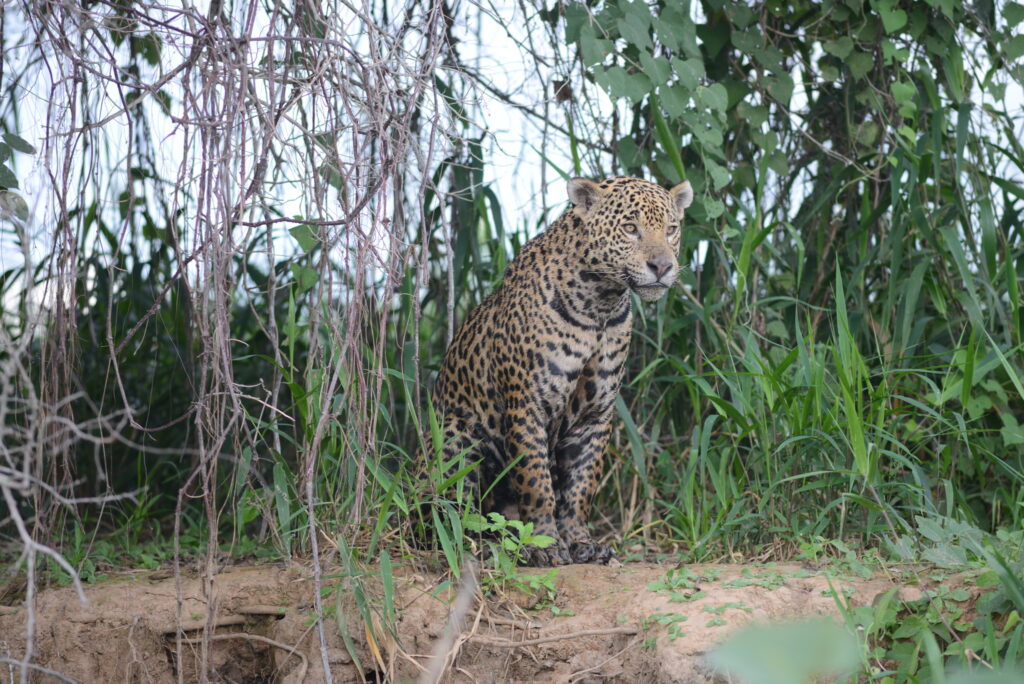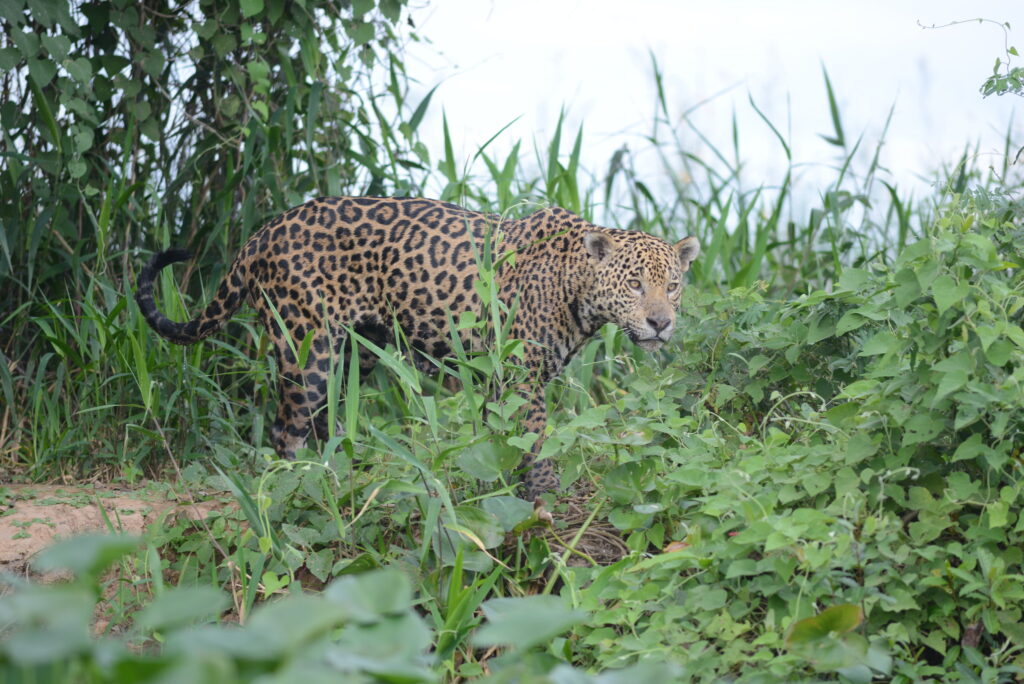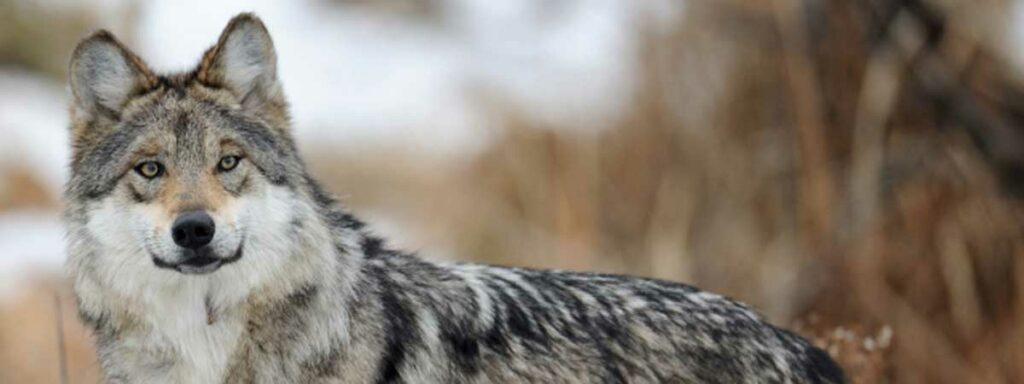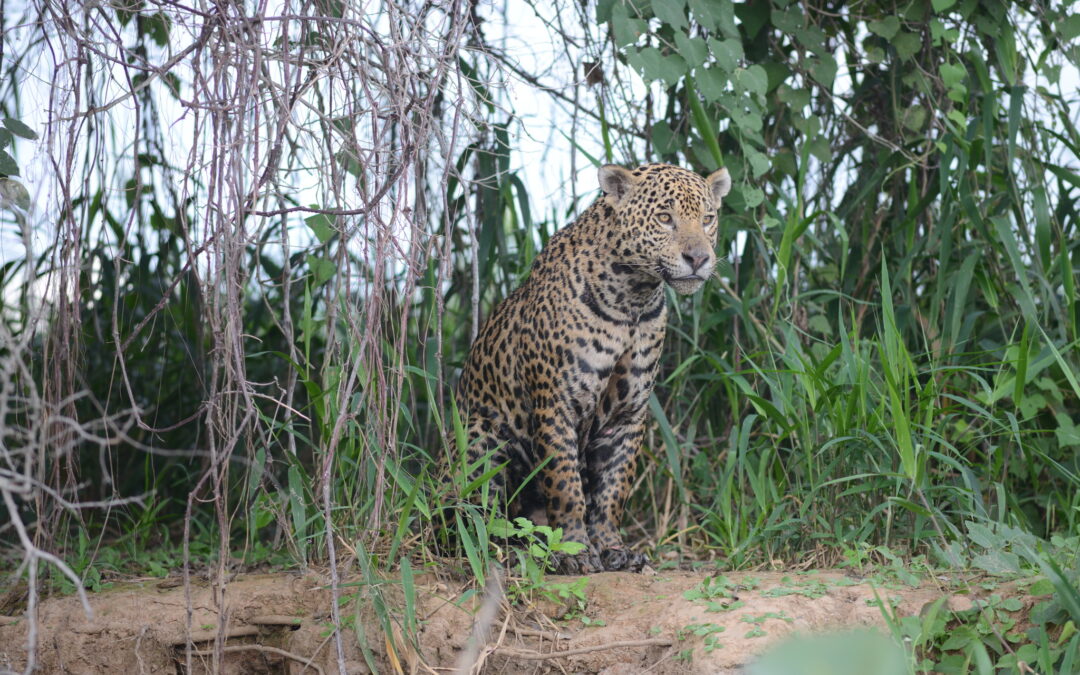
A wild jaguar in western Brazil photographed by B. Phalan
In Central and South America, jaguars serve as indicators of environmental quality, their presence signaling a healthy ecosystem. As apex predators, jaguars benefit biodiversity and help prevent overgrazing of vegetation and soil erosion. Due to their large home ranges and need for connected space, many wild cats are umbrella species. This means their habitat conservation benefits a diversity of plant and animal species. Throughout their range, jaguars serve as umbrella species for other wild felines ranging from pumas (a sympatric carnivore) to small housecat-sized southern tiger cats, as habitat protection and coexistence methods apply to them as well.
An Isolated Habitat
In Brazil, the jaguar’s range spans five distinct biomes: Amazon rainforest, Cerrado savannah, semiarid Caatinga shrubland, coastal Atlantic Forest, and the Pantanal wetlands. Of these five, habitat within the Atlantic Forest biome – a corridor bordering the Atlantic Ocean – is the most fragmented and isolated. As apex predators, these big cats have large home ranges and require a lot of space. Camera trapping data in the 2000s estimated a jaguar population density of 2-2.84 jaguars per 100 square kilometers in protected lands across four of the five biomes (the outlier was the Pantanal, which supported a much higher density of 10.3 jaguars per 100 square km). The Atlantic Forest population is of special concern, as jaguar habitat protected from development within the region mainly consists of several small, isolated Indigenous lands and state and national parks.
As a contiguous stretch of forest within a fragmented biome, the Brazil-Argentina Green Corridor is considered the largest and most critical habitat area for jaguars in the Atlantic Forest. This area consists of 457,000 acres of protected land linking two adjacent national parks, Iguazú in Misiones Province, Argentina, and Iguaçu in Paraná, Brazil. It is a subtropical rainforest containing the largest waterfall system in the world, with about 275 individual falls in the area.
The two parks are home to two big cats – jaguars and pumas – as well as numerous butterfly, reptile and bird species including rare harpy eagles. At one time this area had a robust jaguar population estimated at 400-800. However, numbers sharply declined at the end of the 1990s. By 2005, the Green Corridor population dropped down to just 40 jaguars, 5-10% of prior numbers. An “extinction vortex” seemed imminent, especially on the Brazil side of the park, which counted just 9-11 jaguars by 2009.
Why did the jaguars decline?
Threats to jaguars in the southernmost part of their range mirror those in other regions (habitat loss, livestock conflicts, poaching). The highly fragmented nature of the Atlantic Forest adds an additional barrier to their survival. The Brazil-Argentina Green Corridor is isolated from other jaguar populations – meaning genetic diversity is low. Deforestation in Paraná, Brazil (which lost 13% of its forest cover between 2000 and 2020) was a catalyst for the jaguar decline. While pumas are still present throughout Argentina, jaguars are absent from most of their historic range within the country, down to just a handful of isolated holdouts. Loss of land to development and livestock production in the area surrounding the park further isolated this jaguar population.
While jaguars have protections as endangered species in both localities, human conflict can still be a threat. Many people fear jaguars. With wild prey harder to find in fragmented landscapes, jaguars adapted their hunting behavior. The corridor experienced more frequent jaguar interactions with humans and predation on cattle, leading to ranchers killing more jaguars in retaliation while the population declined.

Cross-border Conservation and Coexistence: A Holistic Approach
Fortunately, the jaguars’ outlook has changed for the better. While the spotted cats have not rebounded to historic levels yet, dedicated conservation efforts successfully reversed their decline. Today, there are at least 105 in the corridor, including at least 28 jaguars on the Brazilian side of the park. In addition, another rare species is making a comeback in this region. Conservationists in northeastern Argentina have recently restored giant otters – a critical keystone species – to their waterways. This rewilding effort marks the otters’ first presence in Argentina since their extirpation 40 years ago. This restoration project, along with the jaguar recovery, shows that conservationists are not just protecting what is left, but working to restore what has been lost.
Community initiatives like the Jaguar Crocheteers – local women crocheting jaguar themed crafts – help raise local awareness and funding for conservation efforts. The Green Corridor jaguar recovery effort is spearheaded by Yara Barros, a wildlife biologist and executive coordinator of the Jaguars of Iguaçu Project. She won the 2025 Whitley Award for her efforts, an honor recognizing conservation work in the Global South. In many ways, women have led the way for the jaguar.
The Jaguars of Iguaçu Project emphasizes coexistence, community outreach and engagement, jaguar population monitoring and research, and education campaigns. Yara Barros offers landowners local resources like secure pen building, coexistence training and ranger-rancher patrols to keep cattle safe from jaguar or puma predation. Having options (and jaguar-proof enclosures) mean livestock producers are more likely to reach out to conservation groups for predator deterrents and training, rather than killing jaguars they see on their land.
Barros’ goal is “turning fear into fascination” – changing local perceptions of big cats from a source of fear to an integral part of the ecosystem. “A lot of fear comes from not understanding,” she said in a feature on Mongabay. “When someone calls us saying they saw a jaguar or had an incident, we respond immediately — even in the middle of the night. This builds trust that we’re here to help solve the problem, so they don’t feel they have to kill the jaguar…We want people to stop seeing them as just big cats and start seeing them as a magnificent species that just wants to exist.”
Jaguar conservation work in the Green Corridor is integrative and collaborative:
- Mitigating the financial impact of livestock predation and providing preventative, nonlethal resources
- Conserving land and standing against further deforestation in jaguar habitat
- The creation of a Paraná state action plan for pumas and jaguars in the region addressing threats specific to these species
- Partnership with a local airport (Foz do Iguaçu) to promote environmental sustainability and jaguar conservation awareness
- Local community initiatives like the Jaguar Crocheteers
- Fostering awe, empathy, and fascination for jaguars – not as a resource, but as wild animals with intrinsic value
- Conducting research and collaboratively monitoring jaguars across the two countries to track populations
- Responsible ecotourism – tourists’ desire and curiosity to see wild jaguars can provide more funding for local conservation efforts
Paradigm Shift
On-the-ground conservation work conducted in places like Paraná and Misiones Province sometimes gets overlooked. The Global North often dominates the narrative around conservation science and policy. For instance, state wildlife agencies and organizations often herald and embrace the North American Model (NAM) as “the world’s best and most successful” conservation model for principles that historically helped rescue certain species like pronghorn, bighorn sheep, and bison from extinction. However, the model is limited in scope. The NAM has drawn criticism for its shortcomings – emphasis on game species and hunting, failure to acknowledge or accommodate relevant stakeholders, exclusion of traditional Indigenous knowledge and conservation solutions, and a long history of hostility towards carnivores. The tenets of the NAM uphold an ideology of settler colonialism, utilitarianism, and individualism, reflecting the beliefs of the sport hunters who established it.

The current system of wildlife management in North America has a strong bias in favor of lethal management. This is especially true with carnivores, even when evidence allegedly supporting liberal or unlimited killing – like claims these animals are negatively impacting game species or domestic animals – is overblown or lacking. Despite conflicts being comparatively rare, our native carnivores like wolves and bobcats are frequently persecuted because they are perceived as a threat to these human interests. The ideology NAM promotes views carnivores as primarily “consumptive natural resources” to be “sustainably used” for hunting and trapping opportunities. The underpinning is that these animals exist for our recreation or otherwise require economic value attached to make them worth conserving.
In addition, North American carnivores are frequent targets of killing contests that devalue and demonize them, stemming from insidious cultural biases against these species rather than scientific basis. Just like jaguar ecotourism, however, photographing or viewing wild wolves or bobcats – who inspire fascination and wonder for many – can provide more recurring benefits and conservation awareness. Conservation work centered around coexistence, mutualism, and intrinsic worth of wildlife, while embraced by a growing number of Americans, is not only resisted by the status quo, but viewed as completely antithetical to the NAM. But should it be?
Jaguar conservation in the Brazil-Argentina Green Corridor is an example of reclaiming relationships with wildlife. We can look to this example of community-led, transformative, and restorative efforts for inspiration. Yara Barros’ work is driven by her compassion for jaguars and a desire for others to become enchanted by them. Jaguars and other wild carnivores deserve to be valued for who they are, not just what utilitarian benefits we obtain from them. Rather than dangerous, lurking predators that rouse fear and are viewed as threats, native carnivores can instead be viewed with empathy, understanding and respect.

This article was contributed by Peggy Clark, a Geospatial Science student at Radford University in Radford, Virginia

